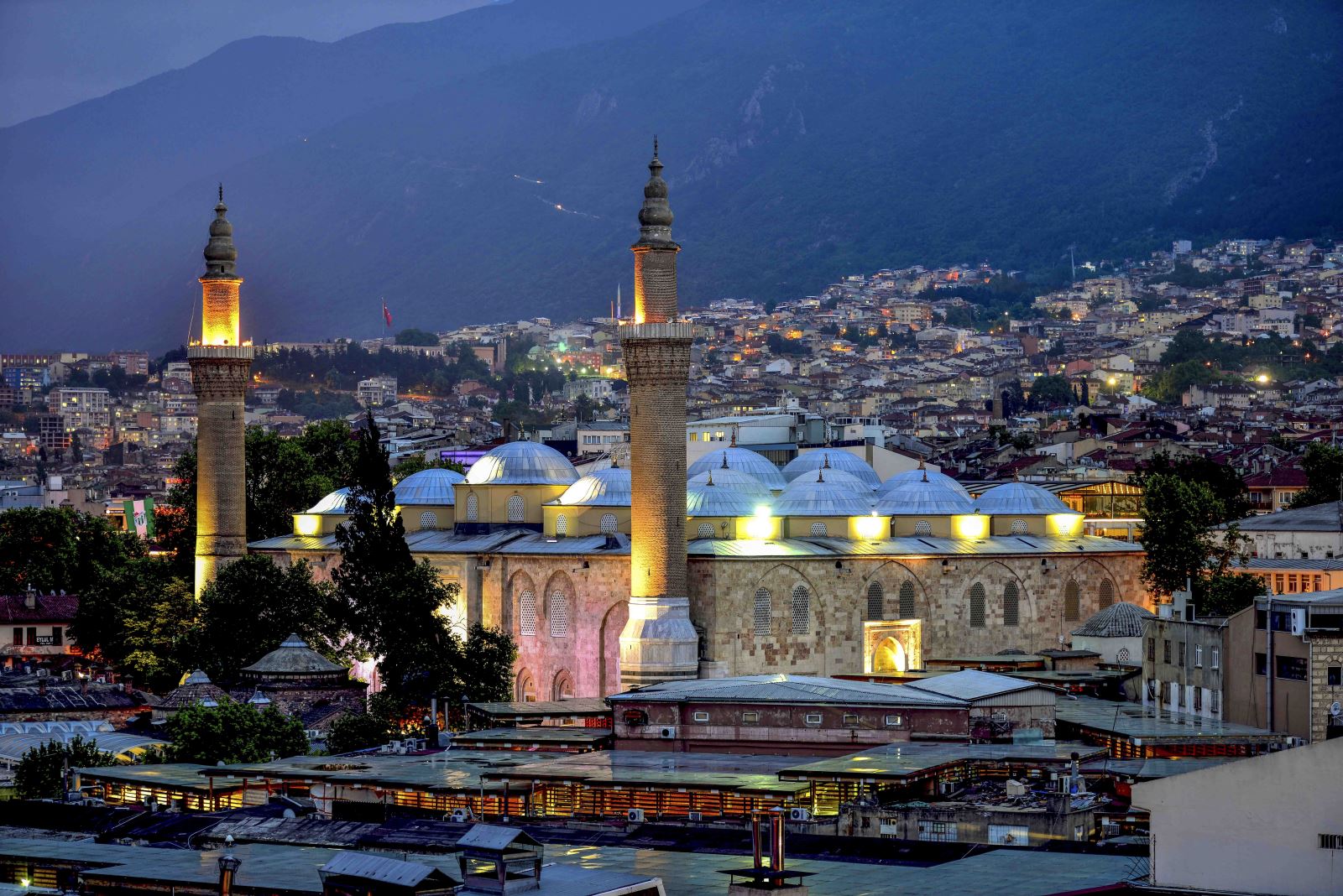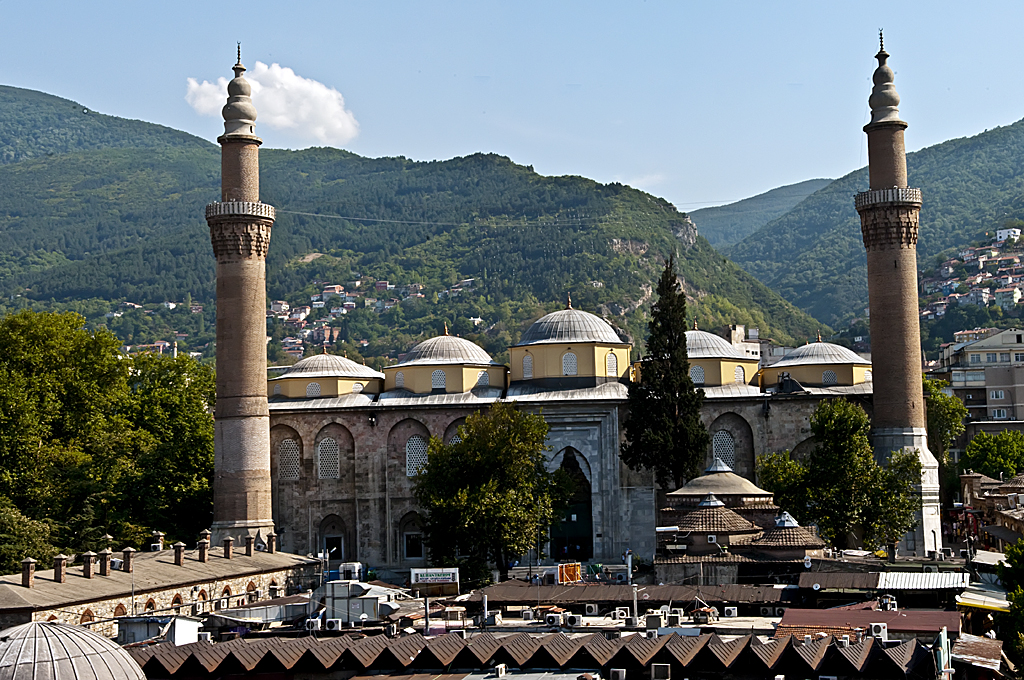Have you ever stepped through the doors of that massive structure standing in the very heart of Bursa, amidst centuries-old plane trees and the bustling bazaar? This is more than just a sanctuary of stone and marble; it's a living history museum where every corner whispers a story and the walls themselves seem to speak. This is the physical embodiment of Sultan Bayezid I's vow to build 20 mosques after his victory at the Battle of Nicopolis, consolidated into one magnificent work upon the advice of his son-in-law, Emir Sultan. In this article, we'll offer you much more than a typical travel guide. Get your list of things to do in the Grand Mosqueready, because this isn't just a visit—it's a journey through time. Are you ready to step into the largest of all the mosques in Turkey that bear the name Ulu Cami?
See the monumental fountain under the 20-domed structure
The moment you step through the mosque's colossal doors, you'll be greeted by a sight that is completely out of the ordinary: a monumental fountain right in the center, illuminated by daylight filtering through a glass-covered dome, its trickling water echoing throughout the space. Don't be surprised to see a fountain in such a central position inside a mosque, because behind this detail lies both architectural genius and a folk legend steeped in justice.
Behind this unique fountain lies a touching legend, passed down through generations, that illustrates the importance of justice and respect. The story goes that an elderly woman owned a small house on the land where the mosque was to be built. Despite all the Sultan's offers, the woman refused to sell her home. Since Islamic law forbade forcible acquisition , that small plot was left empty. What happened next is told in different ways: some sources say the woman's heirs sold the land after her death, while others narrate that she was persuaded by the spiritual counsel of Emir Sultan to donate her property to the mosque. Whatever the outcome, the story explains the reason for that 'void': the belief that worship cannot be performed on land taken by force. Today, that symbol of justice has been transformed into this fountain, filled with the soothing sound of water.

This design does more than just make the Grand Mosque an Ottoman masterpiece; it turns it into a bridge connecting it to the great Seljuk architectural tradition that preceded it. The Seljuk custom of an open-topped dome with a pool beneath is reinterpreted here with Ottoman grandeur. It stands as a concrete testament to how a new empire was built upon the heritage of the past.
Examine the huge and unique calligraphy on the walls
When you lift your gaze from the cool serenity of the fountain, you will find yourself in one of the world's most magnificent calligraphy museums. The walls and the twelve massive pillars are adorned with 192 inscriptions and panels, turning this space into a living gallery. These works, crafted by 41 different calligraphers in 13 different scripts, not only offer an aesthetic delight but also tell a story of rebirth.
Behind this artistic feast on the walls lies a tale of resurgence. The mosque was severely damaged in the great Bursa earthquake of 1855, with 18 of its 20 domes collapsing. However, this disaster also allowed the mosque to gain its present identity. By order of Sultan Abdülmecid, the most skilled calligraphers of the era came from Istanbul and used these walls as their canvas, bringing the mosque back to life. So, the inscriptions you admire today are not mere decorations; they are monuments to the rebirth of a city and its most important symbol from its ashes.

You don't need to get bogged down in technical terms to appreciate these writings. Just look at the giant Vav letters and contemplate how they symbolize humility and servitude to God. Or read the simple yet powerful sentence that will catch your eye on a pillar near the fountain: He who is patient will attain victory. Each inscription on the walls is just one of the thousands of pieces that make up (https://www.yerelrehber.com/en). To feel this spirit more deeply, you must also explore the city's other treasures.
Feel the spiritual and peaceful atmosphere of the mosque
What makes the Grand Mosque special is not just what you see, but also what you feel. The vast interior, covering over 3,000 square meters , the sense of infinity created by the 20 domes supported by 12 thick columns, and the sound of water from the fountain combine to envelop you in an immediate sense of peace and spirituality. This atmosphere is a spiritual legacy carried from the great scholar and mystic Somuncu Baba, who led the first prayer at the mosque's opening , and from the mosque's first imam, Süleyman Çelebi, who penned the famous Mevlid-i Şerif.
On this spiritual journey, there are a few more treasures you shouldn't miss. The first is the black cloth displayed in a glass case next to the Hünkar Mahfili (Sultan's Lodge). This is no ordinary fabric; it is the former door cover of the Kaaba, brought from Egypt by Yavuz Sultan Selim. It is a tangible link stretching from the heart of the Islamic world to Bursa.

And then, look at the minbar (pulpit). Made from walnut wood without a single nail or adhesive using the kündekâri technique, this masterpiece of 6,666 interlocking pieces is an artistic marvel in itself. But this minbar may hold another secret. According to a claim that emerged in the 1980s, the carvings on the eastern face depict the Solar System, with the planets and their proportional distances from the sun. The western face is thought to symbolize a galaxy system. If true, this minbar is not just a sermon pulpit but a silent testament to our ancestors' deep knowledge of the universe and their genius in uniting art and science.
While You're Here...
After leaving the spiritual atmosphere of the Grand Mosque, continue exploring Bursa! Walk over to the historic (https://www.yerelrehber.com/en/city/bursa/things-to-do) right next to the mosque and have a coffee under the shade of the plane trees in its courtyard. Then, lose yourself in the historic
Covered Bazaar and the Khans Region, where you can find everything from handicrafts to spices. If your interest in history continues, take a short walk up to Tophane Park to visit the tombs of Osman Gazi and Orhan Gazi, the founders of the Ottoman Empire. If your time is limited and you want to fit all these beauties into one day, you can check out our
(https://www.yerelrehber.com/en) plan.
Reference: For more academic and official information about the architectural details and restoration processes of the Bursa Grand Mosque, you can review the UNESCO World Heritage Centre page for Bursa and Cumalıkızık: the Birth of the Ottoman Empire.
Frequently Asked Questions (FAQ)
Question 1: Is there an entrance fee for the Grand Mosque, and what are the visiting hours?
Answer: No, entrance to the Grand Mosque is completely free. The mosque is open to visitors from the morning prayer time until the evening prayer time. Please note that tourist visits may be restricted during prayer times, so it is important to be respectful of those who are worshipping.
Question 2: How should I dress for a visit to the mosque?
Answer: Modest clothing should be worn when entering the mosque. Female visitors are expected to cover their heads, and both men and women should wear clothes that cover their shoulders and knees. If you do not have appropriate attire, coverings are usually available to borrow at the entrance.
Question 3: What is the most important feature that distinguishes the Grand Mosque from other mosques?
Answer: Three main features make the Grand Mosque unique: 1) The monumental fountain located right in the middle of the mosque, under a glass dome. 2) The 192 huge and artistic calligraphic inscriptions that adorn its walls like a museum. 3) Being the largest and first multi-domed monumental structure of the early Ottoman period, with its 20 domes.


 English
English Türkçe
Türkçe